Pengpeng Zeng
OmniCharacter: Towards Immersive Role-Playing Agents with Seamless Speech-Language Personality Interaction
May 26, 2025Abstract:Role-Playing Agents (RPAs), benefiting from large language models, is an emerging interactive AI system that simulates roles or characters with diverse personalities. However, existing methods primarily focus on mimicking dialogues among roles in textual form, neglecting the role's voice traits (e.g., voice style and emotions) as playing a crucial effect in interaction, which tends to be more immersive experiences in realistic scenarios. Towards this goal, we propose OmniCharacter, a first seamless speech-language personality interaction model to achieve immersive RPAs with low latency. Specifically, OmniCharacter enables agents to consistently exhibit role-specific personality traits and vocal traits throughout the interaction, enabling a mixture of speech and language responses. To align the model with speech-language scenarios, we construct a dataset named OmniCharacter-10K, which involves more distinctive characters (20), richly contextualized multi-round dialogue (10K), and dynamic speech response (135K). Experimental results showcase that our method yields better responses in terms of both content and style compared to existing RPAs and mainstream speech-language models, with a response latency as low as 289ms. Code and dataset are available at https://github.com/AlibabaResearch/DAMO-ConvAI/tree/main/OmniCharacter.
Towards Generalized and Training-Free Text-Guided Semantic Manipulation
Apr 24, 2025



Abstract:Text-guided semantic manipulation refers to semantically editing an image generated from a source prompt to match a target prompt, enabling the desired semantic changes (e.g., addition, removal, and style transfer) while preserving irrelevant contents. With the powerful generative capabilities of the diffusion model, the task has shown the potential to generate high-fidelity visual content. Nevertheless, existing methods either typically require time-consuming fine-tuning (inefficient), fail to accomplish multiple semantic manipulations (poorly extensible), and/or lack support for different modality tasks (limited generalizability). Upon further investigation, we find that the geometric properties of noises in the diffusion model are strongly correlated with the semantic changes. Motivated by this, we propose a novel $\textit{GTF}$ for text-guided semantic manipulation, which has the following attractive capabilities: 1) $\textbf{Generalized}$: our $\textit{GTF}$ supports multiple semantic manipulations (e.g., addition, removal, and style transfer) and can be seamlessly integrated into all diffusion-based methods (i.e., Plug-and-play) across different modalities (i.e., modality-agnostic); and 2) $\textbf{Training-free}$: $\textit{GTF}$ produces high-fidelity results via simply controlling the geometric relationship between noises without tuning or optimization. Our extensive experiments demonstrate the efficacy of our approach, highlighting its potential to advance the state-of-the-art in semantics manipulation.
Skip Tuning: Pre-trained Vision-Language Models are Effective and Efficient Adapters Themselves
Dec 16, 2024



Abstract:Prompt tuning (PT) has long been recognized as an effective and efficient paradigm for transferring large pre-trained vision-language models (VLMs) to downstream tasks by learning a tiny set of context vectors. Nevertheless, in this work, we reveal that freezing the parameters of VLMs during learning the context vectors neither facilitates the transferability of pre-trained knowledge nor improves the memory and time efficiency significantly. Upon further investigation, we find that reducing both the length and width of the feature-gradient propagation flows of the full fine-tuning (FT) baseline is key to achieving effective and efficient knowledge transfer. Motivated by this, we propose Skip Tuning, a novel paradigm for adapting VLMs to downstream tasks. Unlike existing PT or adapter-based methods, Skip Tuning applies Layer-wise Skipping (LSkip) and Class-wise Skipping (CSkip) upon the FT baseline without introducing extra context vectors or adapter modules. Extensive experiments across a wide spectrum of benchmarks demonstrate the superior effectiveness and efficiency of our Skip Tuning over both PT and adapter-based methods. Code: https://github.com/Koorye/SkipTuning.
GT23D-Bench: A Comprehensive General Text-to-3D Generation Benchmark
Dec 13, 2024Abstract:Recent advances in General Text-to-3D (GT23D) have been significant. However, the lack of a benchmark has hindered systematic evaluation and progress due to issues in datasets and metrics: 1) The largest 3D dataset Objaverse suffers from omitted annotations, disorganization, and low-quality. 2) Existing metrics only evaluate textual-image alignment without considering the 3D-level quality. To this end, we are the first to present a comprehensive benchmark for GT23D called GT23D-Bench consisting of: 1) a 400k high-fidelity and well-organized 3D dataset that curated issues in Objaverse through a systematical annotation-organize-filter pipeline; and 2) comprehensive 3D-aware evaluation metrics which encompass 10 clearly defined metrics thoroughly accounting for multi-dimension of GT23D. Notably, GT23D-Bench features three properties: 1) Multimodal Annotations. Our dataset annotates each 3D object with 64-view depth maps, normal maps, rendered images, and coarse-to-fine captions. 2) Holistic Evaluation Dimensions. Our metrics are dissected into a) Textual-3D Alignment measures textual alignment with multi-granularity visual 3D representations; and b) 3D Visual Quality which considers texture fidelity, multi-view consistency, and geometry correctness. 3) Valuable Insights. We delve into the performance of current GT23D baselines across different evaluation dimensions and provide insightful analysis. Extensive experiments demonstrate that our annotations and metrics are aligned with human preferences.
SeMv-3D: Towards Semantic and Mutil-view Consistency simultaneously for General Text-to-3D Generation with Triplane Priors
Oct 10, 2024Abstract:Recent advancements in generic 3D content generation from text prompts have been remarkable by fine-tuning text-to-image diffusion (T2I) models or employing these T2I models as priors to learn a general text-to-3D model. While fine-tuning-based methods ensure great alignment between text and generated views, i.e., semantic consistency, their ability to achieve multi-view consistency is hampered by the absence of 3D constraints, even in limited view. In contrast, prior-based methods focus on regressing 3D shapes with any view that maintains uniformity and coherence across views, i.e., multi-view consistency, but such approaches inevitably compromise visual-textual alignment, leading to a loss of semantic details in the generated objects. To achieve semantic and multi-view consistency simultaneously, we propose SeMv-3D, a novel framework for general text-to-3d generation. Specifically, we propose a Triplane Prior Learner (TPL) that learns triplane priors with 3D spatial features to maintain consistency among different views at the 3D level, e.g., geometry and texture. Moreover, we design a Semantic-aligned View Synthesizer (SVS) that preserves the alignment between 3D spatial features and textual semantics in latent space. In SVS, we devise a simple yet effective batch sampling and rendering strategy that can generate arbitrary views in a single feed-forward inference. Extensive experiments present our SeMv-3D's superiority over state-of-the-art performances with semantic and multi-view consistency in any view. Our code and more visual results are available at https://anonymous.4open.science/r/SeMv-3D-6425.
MMEvol: Empowering Multimodal Large Language Models with Evol-Instruct
Sep 09, 2024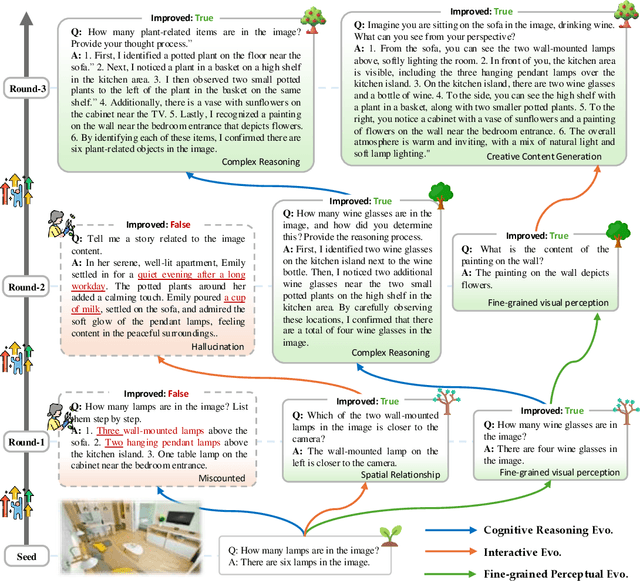

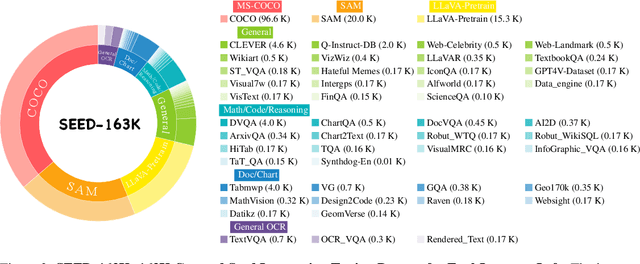

Abstract:The development of Multimodal Large Language Models (MLLMs) has seen significant advancements. However, the quantity and quality of multimodal instruction data have emerged as significant bottlenecks in their progress. Manually creating multimodal instruction data is both time-consuming and inefficient, posing challenges in producing instructions of high complexity. Moreover, distilling instruction data from black-box commercial models (e.g., GPT-4o, GPT-4V) often results in simplistic instruction data, which constrains performance to that of these models. The challenge of curating diverse and complex instruction data remains substantial. We propose MMEvol, a novel multimodal instruction data evolution framework that combines fine-grained perception evolution, cognitive reasoning evolution, and interaction evolution. This iterative approach breaks through data quality bottlenecks to generate a complex and diverse image-text instruction dataset, thereby empowering MLLMs with enhanced capabilities. Beginning with an initial set of instructions, SEED-163K, we utilize MMEvol to systematically broadens the diversity of instruction types, integrates reasoning steps to enhance cognitive capabilities, and extracts detailed information from images to improve visual understanding and robustness. To comprehensively evaluate the effectiveness of our data, we train LLaVA-NeXT using the evolved data and conduct experiments across 13 vision-language tasks. Compared to the baseline trained with seed data, our approach achieves an average accuracy improvement of 3.1 points and reaches state-of-the-art (SOTA) performance on 9 of these tasks.
Text-Video Retrieval with Global-Local Semantic Consistent Learning
May 21, 2024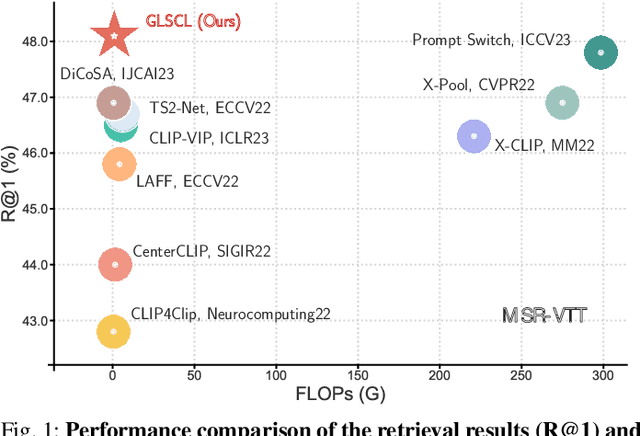
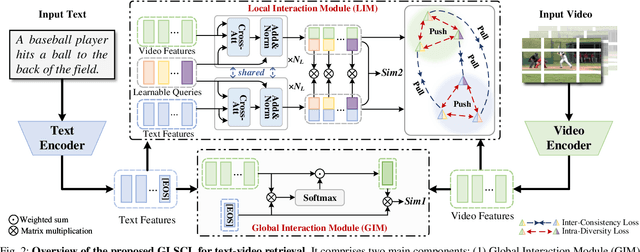
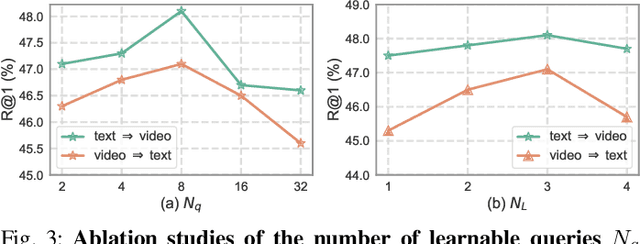
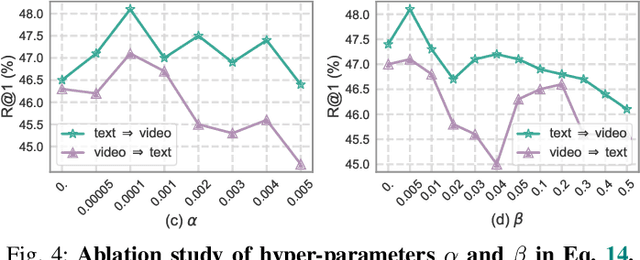
Abstract:Adapting large-scale image-text pre-training models, e.g., CLIP, to the video domain represents the current state-of-the-art for text-video retrieval. The primary approaches involve transferring text-video pairs to a common embedding space and leveraging cross-modal interactions on specific entities for semantic alignment. Though effective, these paradigms entail prohibitive computational costs, leading to inefficient retrieval. To address this, we propose a simple yet effective method, Global-Local Semantic Consistent Learning (GLSCL), which capitalizes on latent shared semantics across modalities for text-video retrieval. Specifically, we introduce a parameter-free global interaction module to explore coarse-grained alignment. Then, we devise a shared local interaction module that employs several learnable queries to capture latent semantic concepts for learning fine-grained alignment. Furthermore, an Inter-Consistency Loss (ICL) is devised to accomplish the concept alignment between the visual query and corresponding textual query, and an Intra-Diversity Loss (IDL) is developed to repulse the distribution within visual (textual) queries to generate more discriminative concepts. Extensive experiments on five widely used benchmarks (i.e., MSR-VTT, MSVD, DiDeMo, LSMDC, and ActivityNet) substantiate the superior effectiveness and efficiency of the proposed method. Remarkably, our method achieves comparable performance with SOTA as well as being nearly 220 times faster in terms of computational cost. Code is available at: https://github.com/zchoi/GLSCL.
Context-based Transfer and Efficient Iterative Learning for Unbiased Scene Graph Generation
Dec 29, 2023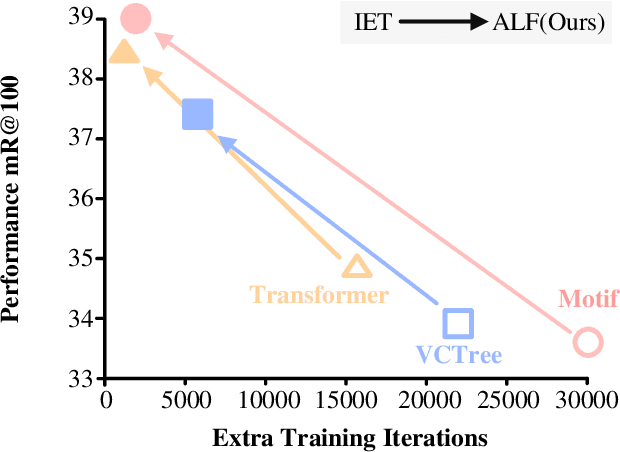
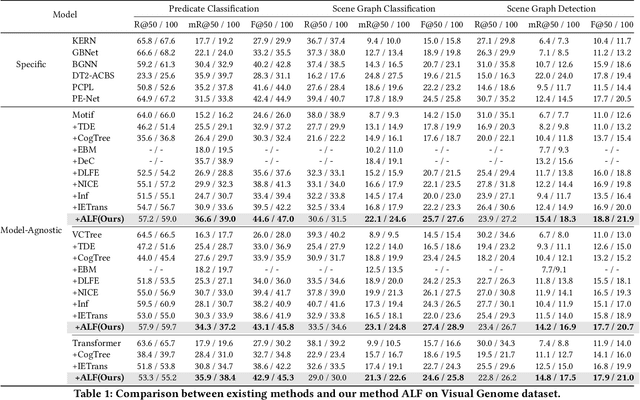
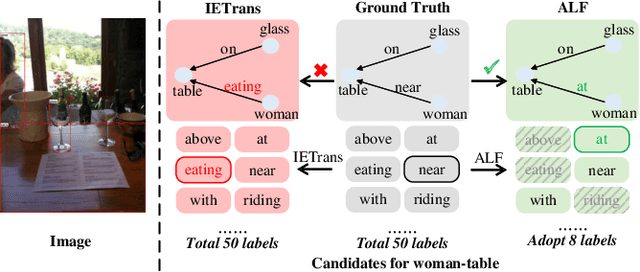
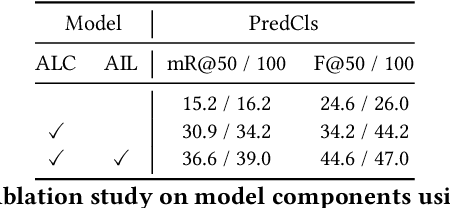
Abstract:Unbiased Scene Graph Generation (USGG) aims to address biased predictions in SGG. To that end, data transfer methods are designed to convert coarse-grained predicates into fine-grained ones, mitigating imbalanced distribution. However, them overlook contextual relevance between transferred labels and subject-object pairs, such as unsuitability of 'eating' for 'woman-table'. Furthermore, they typically involve a two-stage process with significant computational costs, starting with pre-training a model for data transfer, followed by training from scratch using transferred labels. Thus, we introduce a plug-and-play method named CITrans, which iteratively trains SGG models with progressively enhanced data. First, we introduce Context-Restricted Transfer (CRT), which imposes subject-object constraints within predicates' semantic space to achieve fine-grained data transfer. Subsequently, Efficient Iterative Learning (EIL) iteratively trains models and progressively generates enhanced labels which are consistent with model's learning state, thereby accelerating the training process. Finally, extensive experiments show that CITrans achieves state-of-the-art and results with high efficiency.
ProS: Prompting-to-simulate Generalized knowledge for Universal Cross-Domain Retrieval
Dec 19, 2023



Abstract:The goal of Universal Cross-Domain Retrieval (UCDR) is to achieve robust performance in generalized test scenarios, wherein data may belong to strictly unknown domains and categories during training. Recently, pre-trained models with prompt tuning have shown strong generalization capabilities and attained noteworthy achievements in various downstream tasks, such as few-shot learning and video-text retrieval. However, applying them directly to UCDR may not sufficiently to handle both domain shift (i.e., adapting to unfamiliar domains) and semantic shift (i.e., transferring to unknown categories). To this end, we propose Prompting-to-Simulate (ProS), the first method to apply prompt tuning for UCDR. ProS employs a two-step process to simulate Content-aware Dynamic Prompts (CaDP) which can impact models to produce generalized features for UCDR. Concretely, in Prompt Units Learning stage, we introduce two Prompt Units to individually capture domain and semantic knowledge in a mask-and-align way. Then, in Context-aware Simulator Learning stage, we train a Content-aware Prompt Simulator under a simulated test scenarios to produce the corresponding CaDP. Extensive experiments conducted on three benchmark datasets show that our method achieves new state-of-the-art performance without bringing excessive parameters. Our method is publicly available at https://anonymous.4open.science/r/ProS
Generalized Unbiased Scene Graph Generation
Aug 09, 2023Abstract:Existing Unbiased Scene Graph Generation (USGG) methods only focus on addressing the predicate-level imbalance that high-frequency classes dominate predictions of rare ones, while overlooking the concept-level imbalance. Actually, even if predicates themselves are balanced, there is still a significant concept-imbalance within them due to the long-tailed distribution of contexts (i.e., subject-object combinations). This concept-level imbalance poses a more pervasive and challenging issue compared to the predicate-level imbalance since subject-object pairs are inherently complex in combinations. Hence, we introduce a novel research problem: Generalized Unbiased Scene Graph Generation (G-USGG), which takes into account both predicate-level and concept-level imbalance. To the end, we propose the Multi-Concept Learning (MCL) framework, which ensures a balanced learning process across rare/ uncommon/ common concepts. MCL first quantifies the concept-level imbalance across predicates in terms of different amounts of concepts, representing as multiple concept-prototypes within the same class. It then effectively learns concept-prototypes by applying the Concept Regularization (CR) technique. Furthermore, to achieve balanced learning over different concepts, we introduce the Balanced Prototypical Memory (BPM), which guides SGG models to generate balanced representations for concept-prototypes. Extensive experiments demonstrate the remarkable efficacy of our model-agnostic strategy in enhancing the performance of benchmark models on both VG-SGG and OI-SGG datasets, leading to new state-of-the-art achievements in two key aspects: predicate-level unbiased relation recognition and concept-level compositional generability.
 Add to Chrome
Add to Chrome Add to Firefox
Add to Firefox Add to Edge
Add to Edge